Fish and Shellfish Stocks: 2013
Information on the state of fish and shellfish stocks of commercial importance to the Scottish fleet, inclduing Total Allowable Catches (TACs) for each stock.
Nephrops stocks - Biology and Assessment
Latin name :
Nephrops norvegicus
Common names : Norway lobster, scampi, Dublin Bay prawn,
langoustine
Introduction
The fishery for
Nephrops in Scottish waters has developed from landings of
a few tonnes in the early 1960s to over 30,000 tonnes in the mid
2000s. Landings in 2011 of just under 25,000 tonnes had a first
sale value of £86.7 million making
Nephrops the second most valuable species landed into
Scotland. There are
Nephrops fisheries on various grounds around Scotland, the
largest being the Fladen Ground in the North Sea. Most
Nephrops are caught by trawlers, but creel fisheries are
also important, particularly on the west coast of Scotland.
Scotland is allocated the majority of the Total Allowable Catches (
TAC) in both the
North Sea and on the Scottish west coast and takes over one third
of the landings worldwide.
Biology and life cycle
Nephrops distribution is limited by the extent of suitable
muddy sediment in which animals construct burrows. There are
populations in the North Sea and waters to the west of Scotland, in
open waters and sea lochs at depths ranging from a few meters down
to over 500 m on the shelf edge west of the Hebrides.
Nephrops spend most of their time in burrows, only coming out to feed and look for a mate. They are opportunistic predators, feeding primarily on crustaceans, molluscs and polychaete worms. Female Nephrops usually mature at three years of age and reproduce each year thereafter. Mating takes place in early summer. Females spawn in September, and carry eggs under their tails (described as being 'berried') until they hatch in April or May. The larvae develop in the plankton before settling to the seabed six to eight weeks later. Reproductive timing may be slightly delayed in the deeper areas of the Fladen Ground.
Nephrops in different areas grow at different rates and mature at different sizes. This variation is related to the density of animals and sediment type. On the softest mud, Nephrops densities are low, but the animals grow relatively fast, and reach a larger maximum size. The largest animals are colloquially referred to as clonkers. On sandier mud, Nephrops density is much higher, but the animals grow relatively slowly, and are smaller ('beetles'). In the North Sea there are differences in growth between stocks, while on the west coast, there are also differences between areas within the same stock.
Since most Nephrops fishing is by trawling, and because animals are protected from trawls when in burrows, the emergence patterns affect catch rates. The timing of emergence to feed appears related to light level, and greatest catches are often taken at dawn and dusk, although this may vary with water depth and clarity. As 'berried' females rarely come out of the burrow, they are naturally protected from trawlers. Males dominate trawl catches for most of the year, and are more heavily exploited than females.
Assessments
For the purposes of stock assessment,
Nephrops around Scotland are split into a number of stocks
or 'functional units' (
FUs) based on the
discrete patches of mud which they inhabit. Unlike fish,
Nephrops cannot be aged directly and therefore the
assessments make use of size composition data from catches,
combined with information on stock abundance obtained from
underwater television (
UWTV) surveys.
UWTV cameras are
used on research vessel surveys to estimate
Nephrops burrow density on the seabed. The information
gathered provides an index of stock abundance for each
FU which is independent
of the fishery and burrow emergence patterns. By applying a number
of 'correction' factors to the index, an estimate of the absolute
abundance of
Nephrops is obtained. A proxy for fishing mortality known
as the 'harvest rate' is derived as the ratio of total catch to
absolute abundance.
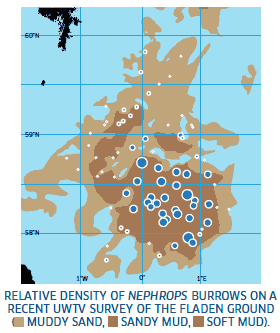
North Sea : ICES Advice on Management
2013 Position :
TAC 17,350 tonnes;
UK share 15,027 tonnes
2011 Landings : 17,200 tonnes
Stock Health : Most stocks fished at around
F
MSY Some show declining abundance although
above
MSY B
trigger
Importance : Key shellfish species
Location : Widespread on muddy grounds
Latest Assessment : May 2012
North Sea stocks
In the North Sea, Scottish fishermen exploit
Nephrops in the
Farn Deeps, Firth of Forth, Moray Firth, Fladen
Ground and to a lesser extent at the Noup and Devil's
Hole. Most are caught by trawlers targeting
Nephrops. In some areas, particularly the Fladen Ground,
they are also caught by whitefish trawlers. The Fladen Ground is by
far the largest
FU, and accounted for
almost 50 % of the total North Sea landings in 2011.
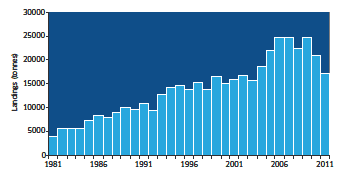
Total International Landings (Tonnes) Of North Sea Nephrops.
State of the stocks
In 2012,
ICES
conclusions about
Nephrops stock status were based on trends in the
UWTV survey,
fishery and catch size composition data.
Farn Deeps: the UWTV survey indicates that the stock status declined after 2005 and has been rebuilding to just below MSY B trigger since 2009. Changes in survey methodology in 2007 make exact comparison with the preceding series difficult, but the general trend is considered reliable.
Fladen Ground: the stock has declined in the last three years but remains just above MSY B trigger. The harvest rate fluctuated around 8% in recent years, which is below F MSY.
Firth of Forth: the stock remains above MSY B trigger but has declined over the last three years. The harvest rate remains above F MSY.
Moray Firth: the stock is declining but remains above MSY B trigger. The harvest rate was just below F MSY in 2010, but increased in 2011.
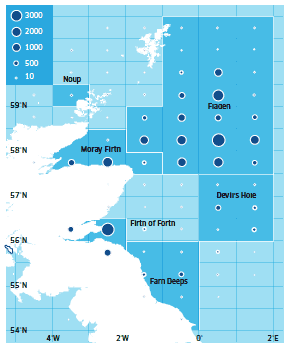
Distribution Of Scottish Nephrops Landings (Tonnes) in the North SEA in 2010 (UK Vessels into Scotland)
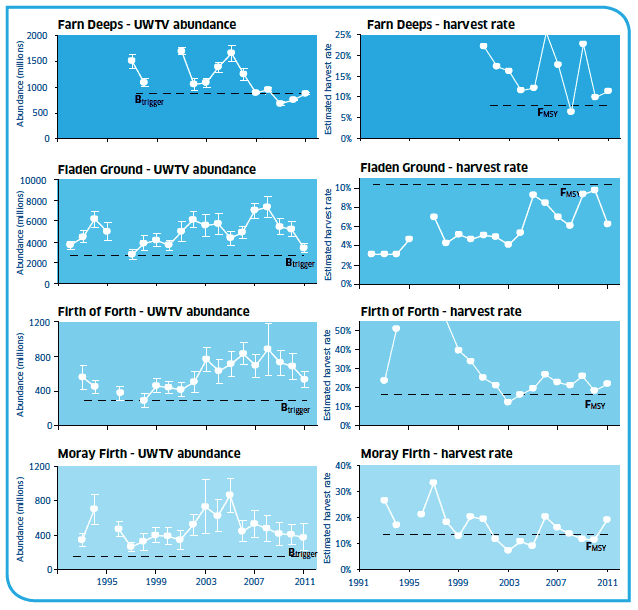
Management advice
The
ICES
advice on future landings is provided on the basis of a fixed
proportion ('harvest rate') of the
UWTV abundance
estimate.
ICES
advised that this 'harvest rate' should be at a level which is
consistent with high long term yield and low risk of depletion of
production potential (
F
MSY). Target harvest rates corresponding to fishing at
F0.1 to
F
MAX (proxies for
F
MSY) were recommended. Where the advice implies a
reduction in harvest rate,
ICES
has advised on the basis of incremental reductions in fishing
mortality towards the target (transition to
F
MSY).
On the basis of this approach, ICES has advised the following limits on landings (for the main FUs of Scottish interest) for 2013:
Farn Deeps 1,400 tonnes
Fladen 10,000 tonnes
Firth of Forth 1,400 tonnes
Moray Firth 950 tonnes
Management action
ICES
management advice is formulated for
Nephrops
FUs, whereas management
has continued to be applied to the larger
ICES
finfish areas.
STECF
supports the
ICES
advice for management at a smaller scale and has emphasised the
need for whitefish by-catch mitigation measures in
Nephrops fisheries.
West Coast : ICES Advice on Management
2013 Position :
TAC 16,690 tonnes;
UK share 16,295 tonnes
2011 Landings : 12, 800 tonnes
Stock Health : Stocks appear to be stable and fished around
or below
F
MSY
Importance : Key shellfish species
Location : Widespread on muddy grounds
Latest Assessment : May 2012
West of Scotland Stocks
On the west coast of Scotland, there are
Nephrops fisheries in the North Minch, South Minch, the
Clyde and the the Sound of Jura, and to a lesser extent at Stanton
Bank. Most of the catch is taken by small inshore trawlers
targeting
Nephrops, but some are caught by larger twin-rig vessels.
Creel fishing accounted for about 20 % of landings in both the
North and South Minch in 2011. Creel-caught
Nephrops are generally larger and in better condition than
those caught by trawling. They attract high prices in the live
export market and provide an important source of income for small
local boats. Creels are used mainly in inshore areas and sea lochs,
where access by trawlers may be limited by the seabed or
legislation. In some areas both fishing methods are used and gear
conflicts sometimes occur.
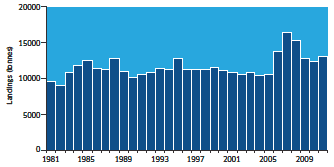
Total International Landings (Tonnes) of West of Scotland Nephrops.
State of stocks
In 2012,
ICES
conclusions about
Nephrops stock status were based on trends in the
UWTV survey,
fishery and catch size composition data.
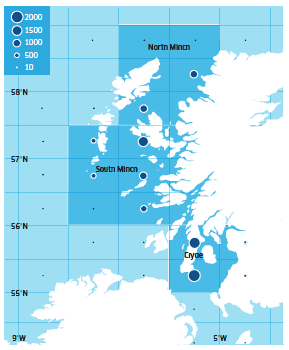
Distribution of Scottish West Coast Nephrops Landings Landings (Tonnes) in 2011 (UK Vessels Into Scotland
North Minch: The stock has been above MSYBtrigger for more than 10 years. The harvest ratios (removals/ UWTV abundance) have fluctuated around the F MSY proxy.
South Minch: The stock has been above MSY B trigger for the full time-series. The harvest ratio (removals/ UWTV abundance) has decreased since 2007 and is now below F MSY proxy.
Clyde: UWTV abundance remains well above the MSY B trigger. Harvest rates for Nephrops in the Firth of Clyde have declined since 2007 but remain above the proposed F MSY proxy. Harvest rates for Nephrops in the Sound of Jura have been well below the proposed F MSY proxy in recent years. UWTV abundance remains higher than observed at the start of the series, but the series is too short and patchy to propose an MSY B trigger.
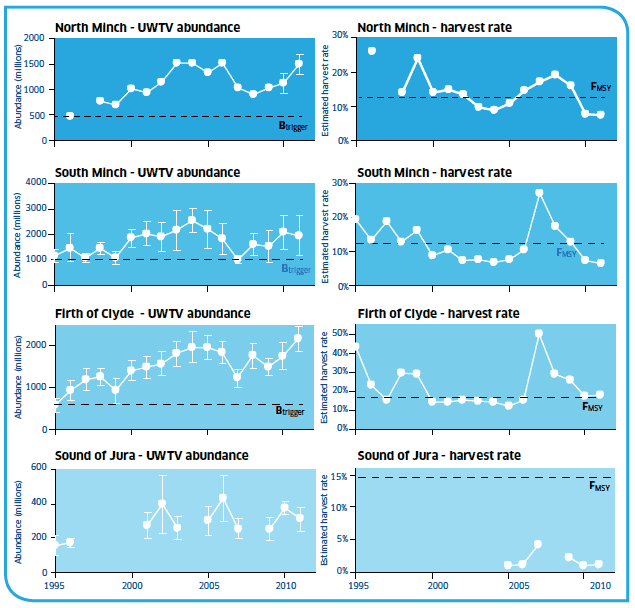
Management advice
The
ICES
advice on future landings is provided on the basis of a fixed
proportion ('harvest rate') of the
UWTV abundance
estimate.
ICES
advised that this harvest rate should be at a level which is
consistent with high long term yield and low risk of depletion of
production potential (equivalent to fishing at
F
MSY). Target harvest rates corresponding to fishing at
F0.1 to
F
MAX were recommended (proxies for
F
MSY). Where the advised harvest rate implies a
significant reduction in catch,
ICES
has advised on the basis of incremental reductions in fishing
mortality towards the target (transition to
F
MSY).
On the basis of this approach, ICES has advised the following limits on landings (by FU) for 2013:
North Minch 4,200 tonnes
South Minch 5,800 tonnes
Clyde 6,400 tonnes
(5,600 t Firth of Clyde + 800 t Sound of Jura)
Management action
ICES
management advice is formulated for
Nephrops
FUs, whereas management
continues to be applied to the larger
ICES
finfish areas.
STECF
supports the
ICES
advice for management at
FU level and has
emphasised the need for whitefish by-catch mitigation measures in
Nephrops fisheries.
Contact
There is a problem
Thanks for your feedback